- Submissions

Full Text
Peer Review Journal of Solar & Photoenergy Systems
Effect of Human Behavior on the Performance of Solar Water Heaters
MJR Abdunnabi1* and Basim Belgasim2
1Center for Solar Energy Research and Studies, Libya
2 Department of Mechanical Engineering, Libya
*Corresponding author: MJR Abdunnabi, Center for Solar Energy Research and Studies, Tajoura, Libya
Submission: September 14, 2018;Published: November 19, 2018

Volume1 Issue2 November 2018
Abstract
Once the solar water heating system is designed, manufactured, and tested according to the relevant standard, it does not mean that the system will perform according to that standard wherever installed. Weather condition and the operating condition play an essential role in the system performance afterward. In this paper, the effect of user behavior on the performance of solar water heaters are investigated using TRNSYS simulation program. The simulation is performed based on measured data of weather conditions and operation conditions in Libya. Results showed that changing the hot water load pattern affects highly the system performance by up to 14% and changing the amount of hot water consumed also affects the performance by over 13%.
Keywords: Long-term performance; SWHs; User behavior; Hot water load pattern
Introduction
The shortage of energy supply has become one of the most stressful issues around the world. The problem has been driven by the growth in living standards and economic development. Domestic water heating, is one of the main energy consumers in residential sector depending on climate conditions, building facilities and users behavior. In USA and European Union, domestic hot water share about 18% and 14% respectively of the total residential energy consumption [1]. In developing country, the situation is worse, for instant, water heating energy consumption in Libya represent 29.8% of the total residential demand [2]. In the same time, the country receives considerable amount of solar radiation every year, about 2200kWh/m2/year in average, which can be contributing to alleviate the problem [3].
Many studies analyzed the performance of solar water heaters based on the interaction between technical specifications, weather data and operation conditions [4-9]. However, little studies were considered the effect of human behavior on the system performance and how to educate users to improve the performance of solar water heating systems. Recent study by Edwards et al. [ 10] on domestic hot water profiles has shown that daily hot water consumption in Canadian residential building is currently 26% lower than the values report by Becker & Stogsdill [11]. This attributed to the developments in user behavior and technology, and to the increase of water and energy costs. Hot water load pattern profiles have been studied by many researchers, a good review of domestic hot water profiles is given by Fuentes [1].
Abdunnabi [12] studied the effect of hot water load pattern on the design parameters of solar water heaters in Libyan dwellings. Three hypothetical hot water load patterns were considered including morning, evening and all-over the day patterns. The study has shown the design parameters of the solar system is affected by the hot water load pattern, and the smallest and cheapest system obtained in the case of all-over day pattern.
Vieira et al. [13] assessed the performance of solar water heaters using multi-parametric sensitivity analysis. 19 technical specifications, site-specific conditions and user behavior parameters were considered to analyze their influence on six performance indicators. Three user behavior indicators were used: end use water temperature, water consumption and load pattern. The study concluded that the user behavior indicators must be considered in the performance analysis framework for solar water heaters. Notwithstanding many researchers conducted on SWHs in Libya, most of studies considered the design parameters and weather data effect. However, the factor of human behavior can play significant role on the performance of these systems in the country. The consumptive habits such as hot water load pattern and end user water temperature, in addition to education and awareness, can affect directly in the technical and economic performance of SWHs. This paper aims to analyze the effect of user behavior on the performance of solar water heaters in Libya. Different hot water load patterns extracted from the typical hot water load pattern of Libyan families, end user water temperature and hot water consumption are implemented in theoretical simulation based on measured weather data at Tajoura city.
Methodology
In order to achieve the objectives of this study, the well-known energy software TRNSYS is used to evaluate the performance of thermosyphon SWH system. The study encompasses energy consumption and solar fraction as performance indicators. The meteorological data is obtained from weather station installed at center for solar energy research and studies (CSERS) at Tajoura city in Libya. The user behavior factors including hot water load pattern, end user water temperature and total hot water consumption are derived from on-site measurements conducted in previous research [2,14]. The design parameters, considered in this investigation, are selected based on the optimum sizing for Libyan family [15]. At the end, all these parameters are implemented in the TRNSYS model and a long-term simulation is performed and analyzed.
Weather Conditions
Table 1:Main monthly weather data of Tajoura city.

The typical northern weather of Libya is selected to investigate the SWHs performance in this study. The meteorological data is obtained from weather station installed at the Center for Solar Energy Research and Studies (CSERS) in Tajoura city 20km east of the capital Tripoli. The station is located in the northern coast area where diffuse ratio is over 30%. Also, the sun duration in this location is less than the average sun duration of the whole country and the annual global radiation is about 1960kWh/m2. The data is recorded and analyzed in hourly, monthly and annually basis. Table 1 presents sample of monthly average values of the main parameters considered in this analysis [16].
Operation Conditions
Figure 1:Typical hot water load pattern of libyan families.
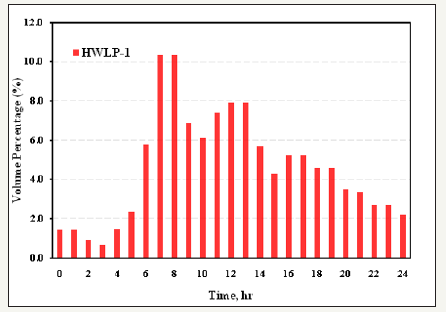
The user behavior parameters which can be measured and implemented in the simulation such as, hot water load pattern (HWLP), end user water temperature and hot water consumption per capita were considered to represent the human behavior. The real values of these parameters for Libyan family hot water consumption per capita is 60 liters at temperature of 45 ˚C. The typical HWLP for Libyan family is illustrated in Figure 1 [ 2].
Figure 2:Four scenarios of hot water load pattern.

In this study, four HWLPs are suggested based on the expected behavior of Libyan people during the day, see Figure 2. These patterns are derived from the typical HWLP-1 in which the general trend is same but peak time of hot water consumption is changed. HWLP-2 and HWLP-3 are predominantly morning consumption with one-hour shift while HWLP-4 and HWLP-5 are predominantly evening consumption with an hour shift. These different scenarios are the most realistic ones can be imagined based on the Libyan culture. On the other hand, typical end user water temperature is 45 ˚C and average hot water consumption per capita is 60 liters. Similarly, different values are suggested and implemented in the simulation in order to see the effect on the performance
System Description and TRNSYS Model
Table 2:Main specifications of the solar water heater.
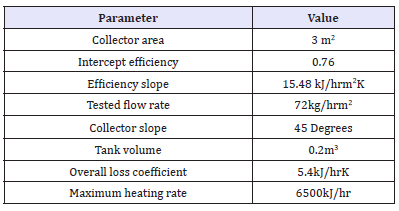
The SWH system adopted in this study is thermosyphon type. Detailed optimization analysis of these systems was conducted by Al Ahjal [15] for Libyan family. The optimum design parameters are adopted in this simulation. The main design parameters are demonstrated in Table 2. In more details, the optimum design system for family of four people in which the system reaches solar fraction between 80 to 90% is around 200 liters tank volume and 3m2 collector area.
TRNSYS Model
The domestic hot water system with thermosyphon solar water heater is implemented in TRNSYS simulation program version 17. Figure 2 demonstrate schematic diagram of TRNSYS model used in this simulation. The system comprises the main components: Thermosyphon system Type 45, weather processor Type 16i, water draw Type 14b, utility components like forcing functions Type 14th, integrators, diverter and mixer. These components are interconnected to simulate the desired domestic hot water heating system.
Results and Discussion
A one-year simulation of the thermosyphon SWH system was conducted with time step of one hour. The simulation of different profiles of HWLP are performed, and the results are presented graphically. The end user hot water temperature was changed from 45 ˚C to 65 ˚C with step of 5 degrees. The hot water consumption was changed as fraction of the total water consumption from 5% to 25%. This section demonstrates the results of these simulations (Figure 3).
Figure 3:Domestic solar water heating system model in TRNSYS.

Effect of hot water load pattern
The five profiles of HWLPs, described early, were implanted in the simulation. Figure 4 & 5 demonstrate the annual solar contribution and energy supplied to user respectively. It can be observed that the solar fraction of morning predominant HWLPs are significantly higher than evening predominant ones. This fact occurred due to continues consumption of hot water during the day activities which exhaust hot water storage. This leads to necessarily boost the electric heater to satisfy the peak at the evening.
Figure 4:Effect of hot water load pattern on the system solar fraction.
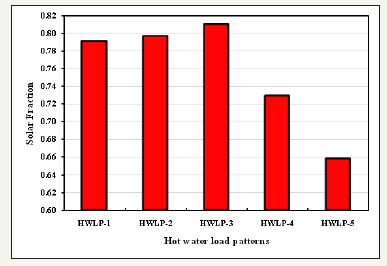
Figure 5:Effect of hot water load pattern on the annual energy delivered from the system.
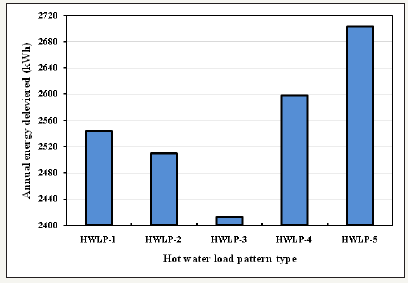
The difference between mornings predominate profiles, HWLP- 1 to 3, is shifting the hot water peak toward the noon. Based on the results, this procedure slightly enhances the solar fraction and reduces the depending on electricity. It is according to the increase in solar radiation intensity during the day. The solar fraction increased from 79% in HWLP-1 to 81% in HWLP-3. Oppositely, the energy consumed by the user drop from 2545kWh to 2410kWh. On the other hand, evening hot water peak demonstrating in HWLP-4 and 5 can degrade the system performance by 14%.
The hot water draw-off profile not only affects the solar fraction, it is also in some cases worsen the energy consumption. As you can see from Figure 5 in case of HWLP-4 and HWLP-5 the amount of energy consumed are higher compared with other cases although the amount of useful energy the same in all cases. This attributed to the fact that in these cases the peak load consumption shifted to the night time were a large amount of energy need to be stored for night use considering the night heat loss.
Effect of end user hot water temperature
Usually solar water heaters require auxiliary heaters to substitute the deficiency of hot water supply in night time and when drawing large quantities in daytime. The set point temperature of the electric element is very important in the efficiency of the solar water heaters. In this work, it has been considered activation and de-activation of the electric heater element and setting the set point temperature of the electric element affected by user behavior. These can be controlled manually by the user in different ways. The effect of set point temperature in the system performance is shown in Figure 6. It is very clear that increasing the set point temperature form 45 ˚C to 60 ˚C will reduce the system solar fraction by over 13%. Raising the set point temperature will activate the electric element more frequently. A slight improvement obtained when manual activation and de-activation of the electric heater’s element in summer and four hours in the noon time are placed. It has found that only 3% and 2% better improvement obtained when the user switched-off the heater in the summer season and noon time respectively as shown in Table 3.
Table 3:Effect of manual activation and de-activation of the electric heater’s element.

Figure 6:Effect of auxiliary heater set point temperature on the solar fraction.
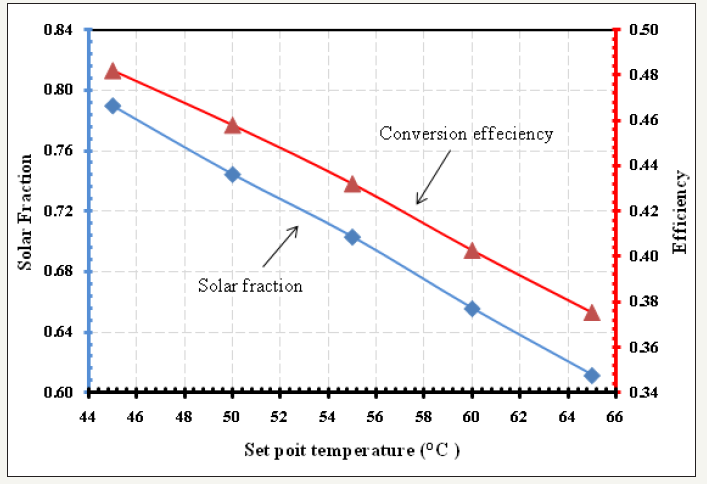
Effect of hot water consumption
Using air bubble taps and reducing un-necessarily use of hot water will save appreciable amount of water. In this sub-section, the effect of reducing the amount of hot water per family is shown Figure 7. It can be seen that reducing the hot water consumption by 25% can increase the solar fraction by 10%.
Figure 7:Effect of reduction of hot water consumption on the system performance.
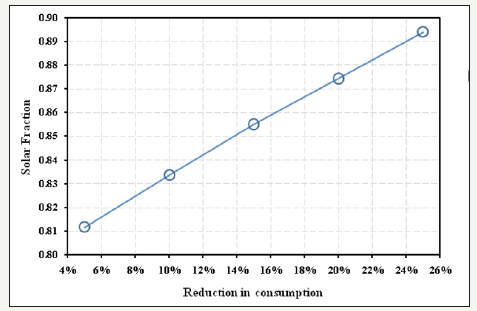
Other factors
Some other factors might be considered to improve the system performance related to understanding and carful use of solar water heaters. Cleaning the system and checking working fluid in the closed loop system are also makes difference in performance among the users, regular checks are very crucial in reliability and durability of the system.
Conclusion
The effect of user behavior on SWHs performance was investigated in this paper. It has been found that typical HWLP is coincident with optimum operation of SWH. However, the study showed little improvement can be achieved in the system performance by carefully considering the timing of hot water drawoff, reducing the set point temperature of the axillary heater and reducing the amount of hot water used by using advanced saving technology or reducing un-necessary excessive use of water.
The study showed in the Libyan environment for a family of four people over 14% improvement in the system solar fraction can be achieved when the axillary set point temperature changed from 45 ˚C to 60 ˚C. Only over 2% improvement in solar fraction can be achieved by changing to the scenario three (HWLP-3) but over 13% degradation in solar fraction might be occur if the behavior changed to scenario five (HWLP-5). The study concluded that educating people with the solar water heating technologies and how it works and how can be utilized efficiently can improve the efficiency, reliability and durability of the system highly.
References
- Fuentes E, Arce L, Salom J (2018) A review of domestic hot water consumption profiles for application in systems and buildings energy performance analysis. Renewable and Sustainable Energy Reviews 81: 1530-1547.
- Abdunnabi M, Dadesh K, Mrehel R, Shamekh N (2016) Effect of full implementation of domestic solar water heaters on the electricity peak load in Libya. JSESD 6(2): 33-43.
- Belgasim B, Aldali Y, Abdunnabi M, Hashem G, Hossin K (2018) The potential of concentrating solar power for electricity generation in libya. Renewable and Sustainable Energy Reviews 90: 1-15.
- Bertrand A, Mastrucci A, Schler N, Aggoune R, Marchal F (2017) Characterisation of domestic hot water end-uses for integrated urban thermal energy assessment and optimization. Applied Energy 186: 152- 166.
- Hobbi A, Siddiqui K (2009) Optimal design of a forced circulation solar water heating system for a residential unit in cold climate using TRNSYS. Solar Energy 83(5): 700-714.
- Saïfed DF, Bouhal T, Gargab F, Jamil A, Kousksou T, et al. (2018). Design and thermal performance optimization of a forced collective solar hot water production system in morocco for energy saving in residential buildings, Solar Energy 160: 260-274.
- Bouhal T, Agrouaz Y, Allouhi A, Kousksou T, Jamil A, et al. (2017) Impact of load profile and collector technology on the fractional savings of solar domestic water heaters under various climatic conditions. International Journal of Hydrogen Energy 42(18): 13245-13258.
- Bracamonte J, Parada J, Dimas J, Baritto M (2015) Effect of the collector tilt angle on thermal efficiency and stratification of passive water in glass evacuated tube solar water heater. Applied Energy 155: 648-659.
- Kostic LT, Pavlovic ZT (2015) Optimal position of flat plate reflectors of solar thermal collector. Energy and Buildings 45: 161-168.
- Edwards S, Morrison BI, Laperrire A (2015) Representative hot water draw profiles at high temporal resolution for simulating the performance of solar thermal systems. Solar Energy 111: 43-52.
- Becker BR, Stogsdill KE (2012) Development of hot water use data base. ASHRAE Transactions 96: 422-427.
- Abdunnabi M (2012) Effect of hot water load patterns on the design parameters of thermosyphon solar water heaters. Proceedings of REVET, Tunisia, Libya.
- Vieira AS, Stewart RA, Lamberts R, Beal CD (2018) Residential solar water heaters in Brisbane, Australia: Key performance parameters and indicators. Renewable Energy 116: 120-132.
- Abdunnabi M (2004) Solar water heaters field project final report. Centre for Solar Energy Research and Studies, Tajoura, Libya.
- Weather Data Department. Natural resources directorate, Center for Solar Energy Research and Studies, Tajoura, Libya.
- Ahjal AM (2017) Optimum sizing of residential active solar water heating systems for Libyan families. MSc thesis, Libyan Academy, Libya.
© 2018 MJR Abdunnabi. This is an open access article distributed under the terms of the Creative Commons Attribution License , which permits unrestricted use, distribution, and build upon your work non-commercially.
 a Creative Commons Attribution 4.0 International License. Based on a work at www.crimsonpublishers.com.
Best viewed in
a Creative Commons Attribution 4.0 International License. Based on a work at www.crimsonpublishers.com.
Best viewed in 







.jpg)






























 Editorial Board Registrations
Editorial Board Registrations Submit your Article
Submit your Article Refer a Friend
Refer a Friend Advertise With Us
Advertise With Us
.jpg)






.jpg)














.bmp)
.jpg)
.png)
.jpg)










.jpg)






.png)

.png)



.png)






